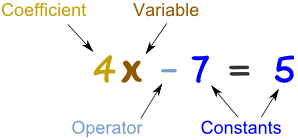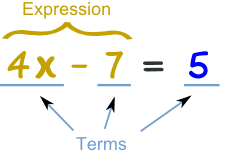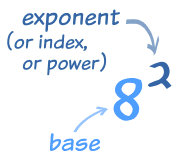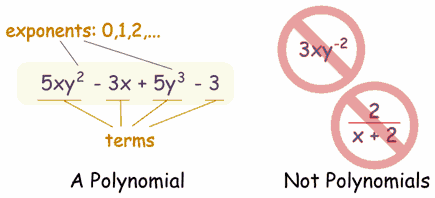Wednesday, 13 June 2012
Basic
What is an Equation
An equation says that two things are equal. It will have an equals sign "=" like this:| x | + | 2 | = | 6 |
So an equation is like a statement "this equals that"
Parts of an Equation
So people can talk about equations, there are names for different parts (better than saying "that thingy there"!)Here we have an equation that says 4x-7 equals 5, and all its parts:
 |
A Variable is a symbol for a number we don't know yet. It is usually a letter like x or y. A number on its own is called a Constant. A Coefficient is a number used to multiply a variable (4x means 4 times x, so 4 is a coefficient) An Operator is a symbol (such as +, ×, etc) that represents an operation (ie you want to do something with the values). |
 |
A Term is either a single number or a variable, or numbers and variables multiplied together. An Expression is a group of terms (the terms are separated by + or - signs) |
Exponents
 |
The exponent (such as the 2 in x2) says how many times to use the value in a multiplication.
Examples:
82 = 8 × 8 = 64
y3 = y × y × y
y2z = y × y × z
|
Example: y4z2 is easier than y × y × y × y × z × z, or even yyyyzz
Polynomial
Example of a Polynomial: 3x2 + x - 2
A polynomial can have constants, variables and the exponents 0,1,2,3,... And they can be combined using addition, subtraction and multiplication, ... but not division!

Monomial, Binomial, Trinomial
There are special names for polynomials with 1, 2 or 3 terms:
Like Terms
Like Terms are terms whose variables (and their exponents such as the 2 in x2) are the same.In other words, terms that are "like" each other. (Note: the coefficients can be different)
Example:
| (1/3)xy2 | -2xy2 | 6xy2 |
Tuesday, 12 June 2012
Polynomial
Definition of a polynomial
Before giving you the definition of a polynomial, it is important to provide the definition of a monomial
Definition of a monomial:
A monomial is a variable, a real number, or a multiplication of one or more variables and a real number with whole-number exponents
Examples of monomials and non-monomials
| Monomials |
9
|
x
|
9x
|
6xy
|
0.60x4y
|
| Not monomials |
y - 6
|
x-1 or 1/x
|
√(x) or x1/2
|
6 + x
|
a/x
|
Polynomial definition:
A polynomial is a monomial or the sum or difference of monomials. Each monomial is called a term of the poynomial
Important!:Terms are seperated by addition signs and subtraction signs, but never by multiplication signs
A polynomial with one term is called a monomial
A polynomial with two terms is called a binomial
A polynomial with three terms is called a trinomial
Examples of polynomials:
| Polynomial |
Number of terms
|
Some examples
|
| Monomial |
1
|
2, x, 5x3
|
| Binomial |
2
|
2x + 5, x2 - x, x - 5
|
| Trinomial |
3
|
x2 + 5x + 6, x5 - 3x + 8
|
Difference between a monomial and a polynomial:
A polynomial may have more than one variable.
For example, x + y and x2 + 5y + 6 are still polynomials although they have two different variables x and y
By the same token, a monomial can have more than one variable. For example, 2 × x × y × z is a monomial
Exercices
For all expressions below, look for all expressions that are polynomials.
For those that are polynomials, state whether the polynomial is a monomial, a binomial, or a trinomial
1) 3.4 + 3.4x
2) z2 + 5z-1 + 6
3) -8
4) 2c2 + 5b + 6
5) 14 + x
6) 5x - 2-1
7) 4 b2 - 2 b-2
8) f2 + 5f + 6
Answer: 1), 3), 4), 5), 6), and 8) are polynomials. 1), 5), and 6) are binomials. 3) is a monomial. 4) and 8) are trinomials
2) and 7) are not because they have negative exponents
Notice that 6) is still a polynomial although it has a negative exponent. It is because it is the exponent of a real number, not a variable
In fact, 5x - 2-1 = 5x + 1/2 = 5x + 0.5
It is subtle, but if you have any questions about the definition of a polynomial, feel free to contact me
Subscribe to:
Comments (Atom)
